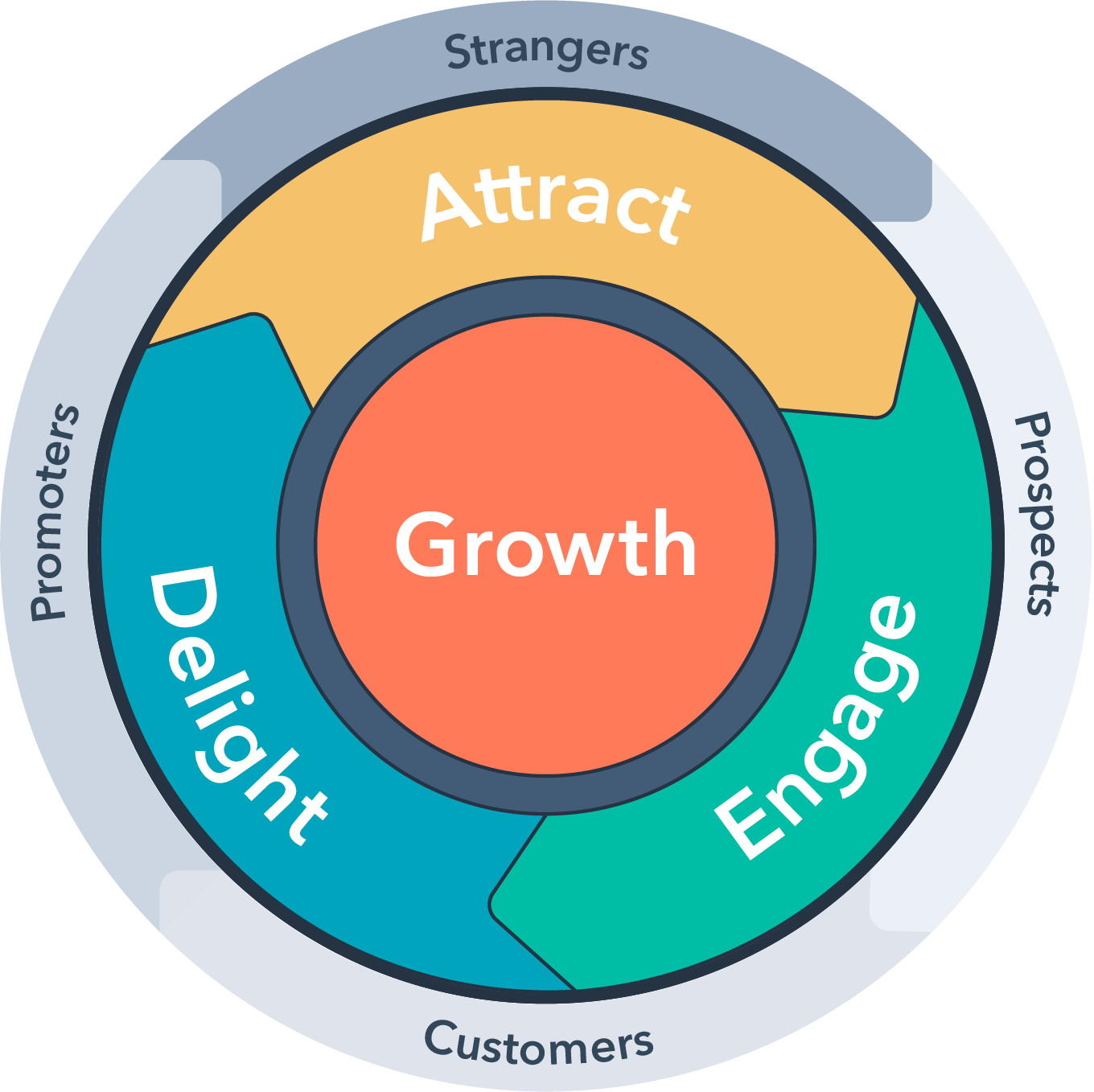If we asked you to name your best marketing asset, what would you say? Your website? Your prices? Your email marketing campaigns? While these elements all contribute to business success, your most promising marketing asset is actually your customers.
Your customers support your enterprise every time they make a purchase, making them the key to successful growth. With that in mind, marketing leaders need to ensure everything they do results in customers feeling satisfied with their buying experience. As you increase the number of happy customers, you’ll also accelerate business growth. This is where the concept of the marketing flywheel and the sales flywheel come into play, emphasizing the continuous momentum generated by a satisfied existing customer base.
To achieve this, we recommend following the flywheel marketing model.
Flywheel Marketing 101
A flywheel is a mechanical device that uses momentum to rotate, which is called the flywheel effect. While marketers have known about flywheel models since the early 2000s, HubSpot, led by Brian Halligan, revived the concept in 2018. The company explained the idea of taking the flywheel and applying it to sales and marketing strategies. Since then, HubSpot has adopted the flywheel model and altered its inbound marketing strategies to match.
Essentially, flywheel marketing keeps the customer at its center. The other stages of inbound marketing — attract, engage and delight — surround the customer. Since the flywheel is a never-ending circle, there is no clear beginning or end to the marketing lifecycle. A satisfied customer creates momentum and keeps the flywheel spinning by referring others to your business, transforming them into brand advocates.
This video from HubSpot provides a visual overview of the flywheel marketing model and how it helps businesses accelerate growth:
How Customers Impact Your Flywheel
Flywheel marketing steps away from the traditional method of looking at customers as conversions. Instead, it empowers marketers to view customers as assets and keep customers involved in growing the brand. While the traditional marketing funnel focuses primarily on customer acquisition, flywheel marketing’s key target is to use customers to drive expansion. Where other models view customers as an afterthought, the flywheel model regards them as an accelerant — making them a critical part of your marketing strategy.
That being said, poor customer experiences or hiccups in the buyer’s journey can cause friction in the flywheel. Customer inconveniences — such as long wait times or disappointments with final product delivery — cause frustration. As a negative force, friction naturally reduces the momentum of your flywheel and hinders business growth.
However, following a flywheel marketing model allows you to monitor drops in momentum and identify areas of friction. From there, you can take necessary action to:
- Determine why customer inconveniences are occurring.
- Develop a plan to reduce friction as much as possible.
- Create a seamless customer experience.
Flywheel Marketing Models in Action
Once flywheel marketing was introduced, HubSpot redesigned its inbound methodology to fit the new model and create the foundation for flywheel marketing tactics. You can apply the 3 phases of inbound marketing to every step of your flywheel model to create an unparalleled customer experience with your brand.

Attract Phase
As a marketer, you need to create helpful and valuable content that attracts new visitors to the brand. As visitors interact with the content, they learn more about your company. The type of content created depends on the target audience and what will best resonate with them. You may develop content marketing materials like blogs, eBooks, video tutorials and social media campaigns to attract new visitors. This is where the power of digital marketing and social media marketing becomes evident, drawing in modern customers through engaging online content.
Engage Phase
Once you’ve attracted new prospects, it’s time to form relationships with them. To drive sales, your content marketing strategy should involve segmenting visitors based on common characteristics. Then, you’ll send those segments personalized promotions or content tailored to fit their needs. The sales team and marketing team must work closely together during this phase to ensure a potential customer becomes a new customer.
Reminder: Don’t view this part of the process as converting leads into sales. Rather, aim to engage with the visitors to establish ongoing relationships. The momentum from these relationships will play a key role in propelling your flywheel and improving business growth.
Delight Phase
The delight phase is all about customer success. Your objective is to do whatever you can to empower your customers to reach their goals. You may be able to achieve this by:
- Distributing post-purchase customer feedback surveys.
- Making UX design changes to your website based on customer feedback.
- Adding self-service customer service chatbots to your website.
- Creating a loyalty program.
- Designing an automatic or more streamlined onboarding process.
This stage is crucial for customer retention and transforming an existing customer into a loyal customer. Customer engagement strategies here can significantly boost the number of happy customers who, in turn, become brand advocates.
Does Flywheel Marketing Work? Let’s Ask Amazon
In 2001, Stanford professor Jim Collins was approached by his former student, Jeff Bezos. In his book, Good to Great, Collins explains how he helped Bezos accelerate Amazon’s growth by introducing the concept of flywheel marketing to its management team. Supposedly, Bezos even sketched a rough draft of what is now the flywheel model on a napkin. From there, Bezos made Amazon focus on creating positive customer experiences. He felt that if he did this, it would increase website traffic and inspire more brands to sell products through the site.
Did it work? Well, we certainly think so, since Internet of Business (IoB) reports that Amazon is currently the world’s second most valuable company — right behind Apple — and its stock market value is over $760 billion.
Subscribe to
The Content Marketer
Get weekly insights, advice and opinions about all things digital marketing.
Thanks for subscribing! Keep an eye out for a Welcome email from us shortly. If you don’t see it come through, check your spam folder and mark the email as “not spam.”
Breaking Down the Funnel vs. Flywheel Debate
The introduction of flywheel marketing led to a debate about which is better: the flywheel or the funnel. Traditionally, marketers visualize the buyer’s journey as a funnel. The focus is to invest in strategies that allow you to widen the top of your funnel and attract as many customers as possible to maintain decent conversion rates. Once you’ve caught the interest of a prospect, you can nurture them through the funnel and, ultimately, generate a sale.
The marketing funnel model focuses on how many customers you can output. The problem, however, is that sales and marketing teams end up devoting large amounts of time, money and energy to converting sales. This results in high customer acquisition costs. Additionally, the model focuses so much on converting leads into sales that it doesn’t allow marketers the time or resources they need to form ongoing relationships and turn buyers into repeat customers.
In contrast, the flywheel model centers on customer experience; they’re what generates the energy that gives your flywheel the momentum to keep moving. Flywheel marketing establishes a more comprehensive and unified way to attract prospects, generate sales, and develop lifelong customers.
This HubSpot video breaks down why it’s time for marketers to start replacing their sales funnels with flywheels:
Flywheel Marketing Allows Customers to Enhance Business Growth
Customers are starting to trust businesses less, which means the shift from funnel to flywheel marketing has never been so critical. HubSpot Research found that:
- 81% of consumers trust the advice of friends and family over professional business advice.
- 65% of consumers don’t trust paid ads, with 71% claiming they don’t trust sponsored social media ads.
- 55% of consumers agree that they don’t trust businesses as much as they used to.
The takeaway: Satisfied customers who advocate for your brand have immense power over a sale. Think about all of the different places you go to learn about a brand or specific product from people rather than sales teams. The list includes:
- Third-party websites: Includes review platforms such as Google, Yelp, TripAdvisor, and Glassdoor.
- TikTok: People can use the #TikTokMadeMeBuyIt hashtag — which has over 4 billion views — to view thousands of product reviews.
- Facebook: Not only can consumers post about experiences with brands on Facebook, but the social media platform also has a feature where users can ask their network for product recommendations.
- Friends and family: Semrush reports that 88% of people have a higher level of trust in a brand when a friend or family member recommends it.
The bottom line is that customers can — and will — influence future buying decisions. By transitioning from a funnel marketing approach to flywheel marketing, you can keep your customers at the center of your strategy. The more customers who are pleased with your services and believe in your brand, the easier it will be for you to attract new prospects and accelerate business growth.
How to Set Up a Flywheel Marketing Model
To make the switch from funnel to flywheel marketing, you’ll need to create unified processes that allow you to efficiently track customer touchpoints. Remember, customer experience is what powers your flywheel. Therefore, all of your marketing efforts must center around creating seamless buying processes and building positive interactions with your brand.
“Customer experience is what powers your flywheel.”
That being said, marketing software can help you effectively track your customers, identify inconveniences, and gather feedback about their experiences. These types of digital tools include:
- Sales CRMs.
- Marketing automation software.
- CMS platforms.
- Real-time feedback software.
Additionally, you’ll want to keep these flywheel marketing best practices in mind when developing a flywheel marketing model:
- Understand the 3 core focus areas of inbound marketing — attract, engage, and delight — and use them to drive customers through the buying cycle.
- Set up metrics — such as cost per acquisition, retention rates, and email signups — for each stage.
- Monitor customer touchpoints for friction and take immediate action to rectify concerns.
- Evaluate your results and look for ways to make continuous improvements to the cycle.
And, most importantly, throughout every stage of the flywheel marketing model, keep the customer experience at the core of everything you do.
Switch Your Marketing Strategy and Watch Your Business Grow
While making the leap from funnels to flywheels can feel daunting, it’s definitely worth it. By letting a positive customer experience drive your marketing efforts, you’ll create a network of loyal customers who are happy to advocate for your brand. The result? Your business will attract new prospects, develop loyal customers who continue to support your brand and, ultimately, grow its revenue.
With all of that said, it’s essential to note that this isn’t the first — and definitely not the last — time that marketing strategies have evolved to empower more profitable growth. Make sure you’re staying in touch with the latest updates within the marketing world by subscribing to The Content Marketer now.
Editor’s note: Updated April 2024.





